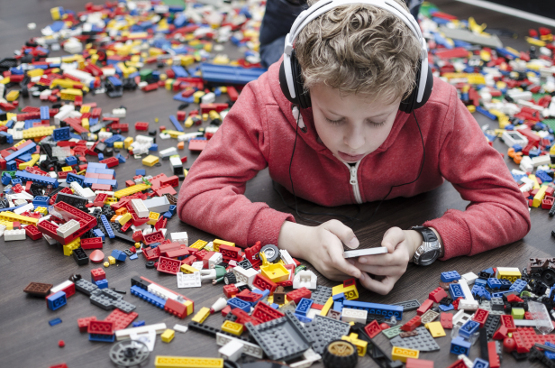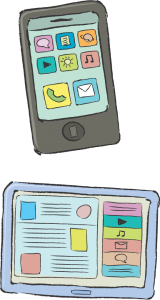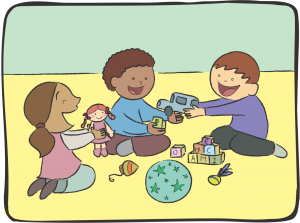
A couple arrives at a restaurant with a child of approximately two years of age. The client at the next table imagines that her chance to have a peaceful dinner is at risk. After putting the child into a high chair, the mother quickly gives her a tablet. The dinner then proceeds peacefully without the parents being inconvenienced. The inconvenience, however, surprisingly comes from the next table. The same client, who previously expected the commotion characteristic of a child of that age, is now surprised by the fact that, even by the end of her meal she was unable to find out whether the girl knew how to speak.
In a São Paulo commuter train, most passengers travel using earphones connected to their respective cell phones. Thus, they choose what they do and don’t want to hear. During the trip of approximately 15 minutes, one passenger chooses to listen only to the ambient sound and is attracted by a child’s voice. Sitting in her mother’s lap, a girl, also of about two years of age, is enchanted by the view from the window and, in a loud voice, makes enthusiastic comments about everything she sees. The polluted Pinheiros River catches her attention and she thinks it is a beach. Enthusiastically, the child makes plans to take her “granny” and “auntie” to play ball with her on the “bleach.” Without taking her eyes off her cell phone, the mother only responds to her daughter’s comments with disinterested expressions like “ahah” and “really,” while she navigates the social media network. Arriving at her station, the passenger who observed the scene leaves the train enchanted with the energy of that child and sad about the loneliness of the child who continues travelling.

Whether in the restaurant or in the public transport, it is possible to observe that technology, very early, is replacing real experiences and interactions in children’s lives. According to the Brazil TIC Kids Online 2015 research study conducted by the Center for Studies on Information and Communication Technologies (CETIC.br) of the Internet Administration Committee in Brazil, 79 percent of children and adolescents from 9 to 17 years of age are internet users.
In the A and B classes, the percentage of children and adolescents connected reaches 97 percent, followed by the C class at 84 percent. The C and D classes, although economically worse off, already have half of their children and adolescents using the internet (51 percent). Data like this, although it represents an advance in relation to democratization of information access, also causes the concern of parents and specialists.
For psychologist Carla Cavalheiro Moura, with a graduate degree in Mental Health in Childhood and Adolescence from the São Paulo School of Health Sciences, it is already possible to see the clinical effects of the early insertion of technology in children’s lives. Memory problems, difficulties with posture, pain in the fingers and joints, as well as impaired nighttime sleep are some of the implications in the physical development of children. “Another important issue is that when the child is inserted in the internet world, it stops playing with the real world, with a consequent impact on its general cognitive development,” she says.

The impact of a lack of activities and play in children’s physical and cognitive development is also perceived daily at the Nosso Lar Social Assistance and Promotion Center (CAPS) in São Paulo, which assists children and adolescents from 0 to 14 years of age from low-income families. “We had a child who entered the day care center at three years of age and was unable to climb onto a toy because her leg muscles were so weak. She just sat in front of the TV,” says Vana Portioli, a member of the CAPS Fundraising and Institutional Relations staff. She says that there are plans in day care centers to keep children busy and promote their intellectual and physical development in keeping with the age, as well as offer them healthy food and rest time. The child recovered after three months of activities to strengthen her muscles.

Technology replacing play is also noted in a survey conducted by the State University of Campinas (UNICAMP) with children from 8 to 12 years of age: those who spend many hours in front of electronic screens do not play in the real world. For Carla Moura, who has worked for 25 years in the clinical area, what is happening today with children is the replacement of the real world by the virtual world, a phenomenon previously more common with adults. “Electronics like tablets and smartphones are offered to children today to keep them busy. It is the so-called digital pacifier. Electronic devices should not be seen as toys and even less as something to keep children busy,” she warns.
Beyond the virtual world, the psychologist gives simple examples of how it is possible to keep children busy in public environments. In a pizzeria, the tip is to ask for a piece of dough and let the child play with it as modeling clay while waiting or even during the meal. Another idea is to keep crayons and paper in your purse so that they can draw. But she also points out that for a child’s own cognitive development it is natural to not spend a lot of time with a single toy or play activity. “Often, what parents want, incorrectly, is for the child to keep quiet watching a film,” she comments.
The psychologist furthermore explains that when technology replaces play, it causes damage to a child’s socialization. “There are studies that show that a child ends up talking less when interacting with a tablet, but not by speech. The lack of concrete play also impairs speech development,” she warns.

For the expert, children younger than two years of age should be stimulated in a way to develop physically and mentally by means of play and toys and not by technology. This is also suggested by a basic manual produced by the Brazilian Society of Pediatrics (SBP) available on the internet. According to the document, “scientific studies show that technology through the digital world influences behavior that can harm and damage health, modifying habits as early as infancy.”

The SBP manual further states that “early and prolonged use of online games, social networks and various internet applications with films and videos can cause difficulties in socialization and interaction with other people, as well as academic difficulties” and that “dependence on problematic and interactive use of media causes mental problems,” among other consequences just as serious. In addition to pointing out the risks, the document also provides guidance to parents and those responsible on more appropriate conduct for each phase of child and adolescent development with regard to technology use.
For parents, Carla suggests that they offer other types of toys and play to children, especially those that promote physical movement, avoiding, for example, problems of undesired weight gain and obesity. “A smartphone is not a toy, a tablet is not a toy, nor are they birthday presents to be given to a child,” she concludes.

Vana Portioli, of CAPS, also emphasizes the importance of parents changing their behavior to serve as positive models for their children. “Parents not only have to talk to their children, they have to provide an example. If parents are glued to their devices, their children will be too. Instead, it’s good to look for places where the kids can engage in activities, take courses, go for walks outside, etc.,” she says.

And it is from China, a country where technological dependence has already been recognized as a public health problem that a video comes with advice for all parents:
Limits
“Limits with regard to use of technology should be established by parents right from the start”
Carla Cavalheiro Moura – psychologist
If excess technology can negatively affect children’s physical and cognitive development, the problems are even greater for adolescents. General anxiety, depression, social phobia and difficulty concentrating are some of the symptoms generally associated with abusive use of technology by adults and adolescents. This is affirmed by psychologist Carla, who is also a staff member of the Technological Dependencies Program of the Impulse Control Disorders Outpatient Unit (PRO-AMITI) of the Psychiatry Institute of the Clínicas Hospital of the University of São Paulo’s Medical School.
And the problems may not end there. Recently, a wave of suicides by young people after participating in internet games shocked the world and left many parents in a state of alert.

For Carla Moura, in the case of adolescents, what happens is that parents think that by being in their room with electronic devices, their children are protected. Furthermore, according to the psychologist, what occurs is isolation of these children within the home. “They grab their electronic device, and this occurs in any social class, and remain inserted there in that world. I tell parents that sometimes the child is much more exposed when alone in his/her room without any type of parental restrictions or monitoring. The parent’s role is to be together,” she emphasizes.

In the U.S., specialists already compare excessive use of electronics in childhood and adolescence to drug dependence. What may seem an exaggeration at first sounds even more dangerous if we think of technology as a “drug” that cannot be avoided. “In the case of technology, it is impossible to tell a person to stop using the internet. A major effort to build a self-regulation system is needed, something that has not been done,” explains the professional.

In addition to behavioral problems, excessive use of technology can also cause physical damage such as brain tumors over the long term. The risk, in this case, is from exposure to microwaves emitted by cellular devices. This is affirmed by American sociologist and doctor of public health Devra Devis. Author of the book, Disconnected, in which she presents research that seeks to prove the risks, Dr. Devis warns that the danger is greater in the case of children, whose brains are still developing.
According to Carla Moura, the only solution to avoiding excesses is to establish limits and regulate technology use by children. “Parents need to always monitor what their child is doing and always be together at times when the child is watching or playing something. It is necessary to first listen and watch what the child is doing and not immediately start criticizing. Often parents don’t know anything about the game their child is playing, she says.
In addition to parents, actions by educators can also be important in this context. This is affirmed by teacher and service manager of the Seara Bendita Child and Adolescent Center (CCA), in the sub district of Cidade Ademar, in São Paulo, in the state of São Paulo, Elisângela Maria da Silva Paes. For her, the role of the educator is to provide guidance and build socio-educational strategies so that children and adolescents can take advantage of all the resources available in this virtual world in a conscientious manner. “The educator should be a mediator between the old and the new, promoting discussions on the benefits and dangers of technology use in day-to-day life,” she says.

The discussion on internet use is also present in our projects, as in the case of Criança é Vida Educação Sexual (Child is Life Sex Education), focused on children from 7 to 12 years of age and adolescents from 13 to 15, which warns of the risks of sexual abuse and exploitation, and overexposure on social networks.
For Vana, of CAPS Nosso Lar, “the suggestion is that when giving internet access to their children, parents be vigilant in monitoring the content accessed, so as not to later have to repair the damage caused in their lives.”
Support
In São Paulo, parents who need help dealing with the problem at home can count on the service offered by the Technological Dependencies Program of the Impulse Control Disorders Outpatient Unit (PRO-AMITI) of the Institute of Psychiatry of the University of São Paulo’s Medical School. Psychologist, family therapist and coordinator of the program’s Family Group, Dr. Sylvia van Enck Meira, explains how PRO-AMITI works.
In 2007, when it was created, PRO-AMITI served adult and adolescent patients, as well as their families. Today, adolescents are not among the patients, but their family members can receive support. “We have an open group that also helps fathers, mothers and other family members of people who are no longer registered as outpatients; this includes adolescents,” explains the coordinator. An ongoing project intends for the service to again service this public as well.
Of the population undergoing treatment, men from 18 to 34 years of age are those most involved with online games, which are the cause of most of the dependency cases assisted by the program. With respect to social class, Dr. Sylvia Meira’s experience at PRO-AMITI shows that the belief that the problem is greater for wealthier classes with more resources to purchase electronics is not borne out. “What we have seen is that in the middle and lower middle classes, in which the parents do all they can to be able to offer the best to their children, the problem is quite widespread,” says the psychologist.
This is also observed by manager Elisângela Paes in the Seara Bendita CCA. The CCA develops socio-educational activities for children and adolescents from 6 to 15 years of age in situations of vulnerability and risk. “When I engage in activities with families, I see that practically all have access to technology and, in most cases, access the internet through cell phones. They often allow their children and teenagers to use technology in an exaggerated manner without control and without a notion of how to educate their children,” she says.
The PRO-AMITI psychologist explains that the objective of the family meetings is to help them understand what is causing their family member to seek refuge on the internet. This is done by listening to their complaints and difficulties. “Parents normally feel impotent to help their children,” she says.

Among the adolescents dependent on online games whose parents are assisted by PRO-AMITI, most are only children of separated parents or single mothers. “The mother leaves to go to work and has no way to monitor her child, who ends up very lonely to take care of everything,” says the family therapist.
According to the specialist, parents, in general, take a long time to seek help, when the situation is out of control, including attempts at suicide. Her recommendation to parents is that they redouble the attention and not be afraid of imposing limits, even when their children’s reaction is very often violent. For her, if parents choose not to interrupt their children when they are playing, they end up becoming “accomplices” to the situation, leading to a very high risk. “Try to talk, promote dialogue, and also establish limits while you can,” she concludes.
Every month the PRO-AMITI professionals take turns offering lectures open to the public. To participate in the family group or see the event schedule, just call (11) 2661-7805. The program website also describes a number of behaviors that may indicate dependence. A warning for all of us.
